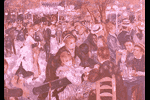Girl with a Watering Can

"Le
Moulin de la Galette by Pierre-Auguste Renoir depicts a
Popular Parisian dance hall. Throngs of people have
gathered; some people crowd the tables and chatter, while
others dance energetically. So lively is the
atmosphere that viewers can virtually hear the sounds of
music, laughter, and tinkling glasses. The whole scene
is dappled by sunlight and shade, artfully blurred into the
figures to produce just the effect of floating and fleeting
light the Impressionists so cultivated. Renoir's
casual unposed placement of the figures and the suggested
continuity of space, spreading in all directions and only
accidentally limited by the frame, position viewers as
participants rather than as outsiders. Whereas
classical art sought to express universal and timeless
qualities, Impressionism attempted to depict just the
opposite - reality's incidental, momentary, and passing
aspects."
- Gardner's
Art Through The Ages,
11th edition, Vol. II, p. 909
Le Moulin de la Galette

On the Terrace

Two Little Circus Girls (Or Girls with Oranges)

"By
1886 most critics and a large segment of the public accepted
Impressionists as serious artists. Just when their
images of contemporary life no longer seemed crude and
unfinished, however, some of these painters and a group of
younger followers came to feel Impressionists were
neglecting too many of the traditional elements of picture
making in their attempts to capture momentary sensations of
light and color on canvas. In a conversation with
influential art dealer Ambroise Vollard in about 1883,
Renoir commented: 'I had wrung Impressionism dry, and I
finally came to the conclusion that I knew neither how to
paint nor how to draw. In a word, Impressionism was a
blind alley, as far as I was concerned.' By the 1880's
four artists in particular were much more systematically
examining the properties and the expressive qualities of
line, pattern, form, and color:
Vincent van Gogh,
Paul Gaugin, Georges Seurat, and
Paul Cezanne. ...
[These] four artists and others sharing their views have
become known as Post-Impressionists. This
classification also signifies their chronological position
in nineteenth-century Western painting."
- Gardner's
Art Through The Ages,
11th edition, Vol. II, p. 916
|